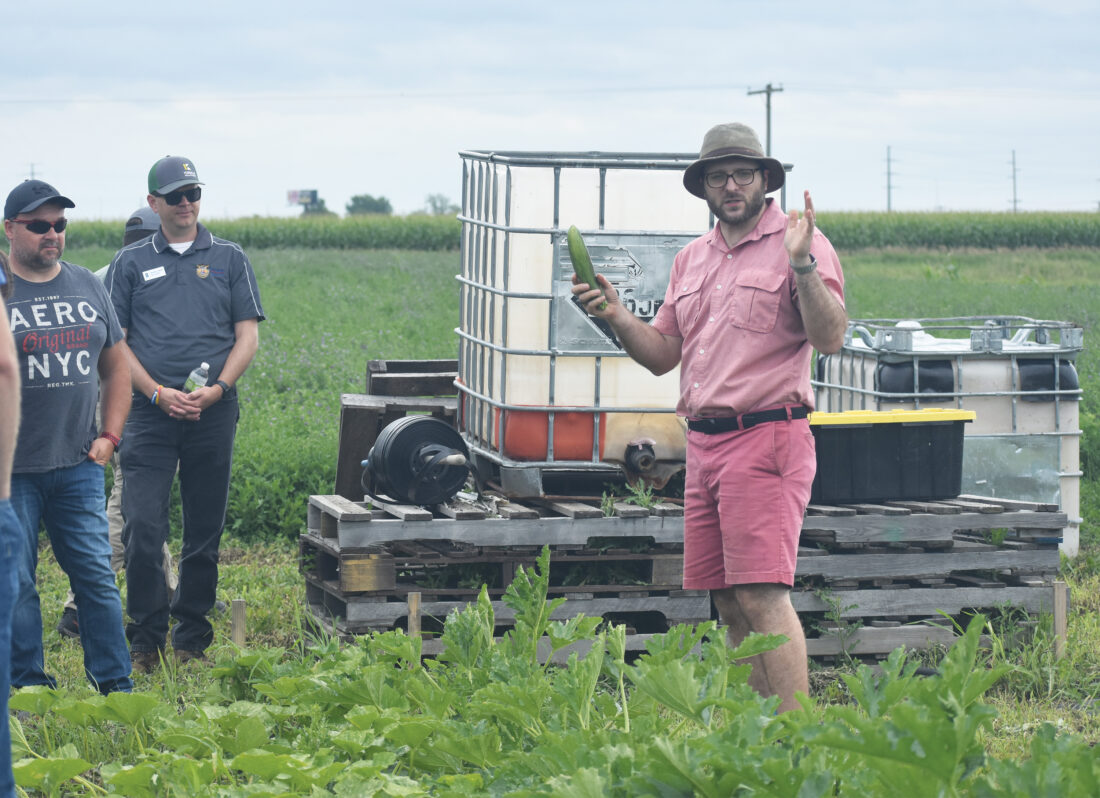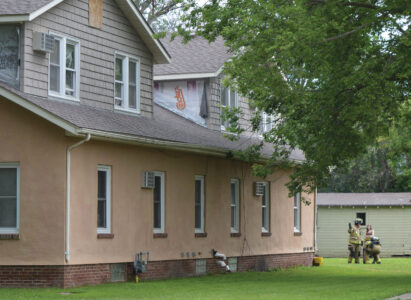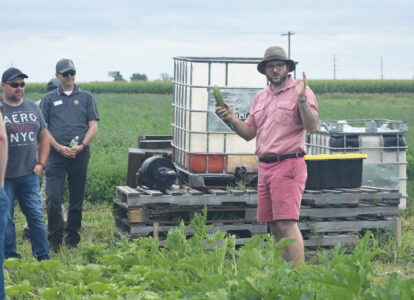Students scout for pests and culinary delights
SMSU hosts seventh annual Agronomy Field Day with tour of research plots

Photo by Samantha Davis SMSU Agronomy professor Dr. Adam Alford (right) showcases one of the farm plots growing zucchini at the seventh annual SMSU Agronomy Field Day Friday afternoon at the SMSU Agronomy Field Trials Farm site.
MARSHALL — Hands-on educational research projects were on display during the seventh annual Southwest Minnesota State University Agronomy Field Day Friday afternoon.
A large part of the day was getting an inside look as to what current students are studying at the farm site, and their process in doing so. SMSU Agronomy professor Dr. Adam Alford welcomed the group to tour the demonstration and research plots to see first-hand the work being done.
“We use the field plots to scout for various insects, corn, soy, wheat, zucchini and squash,” Alford said. “A lot of my students end up working as crop scouts, where they go and scout the fields and get that information to the farmer … The culinology students have (also) been out here to harvest various crops, and they’ve used it in their dishes.”
Alford also noted that the plots serve a purpose to a range of students beyond the agriculture department, as biology and environmental students often visit the plots for work as well.
“Overall, we are doing a lot for hands-on education out here at the SMSU research plots,” Alford said.
Alford first showed a plot growing zucchini, encouraging the group to personally take some home, and said they donated about 300 pounds earlier in the week.
“They (students) come out here, and they collect around 30 and 40 insects. They need to identify them down, especially through the scouting report,” Alford said regarding one of his classes. “They need to decide on whether we should spray or not … It’s a good thought exercise on when to actually spray insecticide.”
“The biggest pest that we usually have out here for the cucurbits is squash vine borer … Those things are really hard to kill. They’re a concealed pest, so they lay their egg in the base of the plant,” Alford added. “These varieties seem to be pretty resistant to it. Zucchinis are always pretty resistant, I’ve had pumpkins out here before, butternut squashes are also pretty resistant.”
The tour moved onto SMSU’s corn and soy plots, seeing updated tools used for research like a drone and a Normalized Difference Vegetation Index (NDVI) sensor.
“It’s a hands-on focused learning opportunity for students. Nothing groundbreaking, but we have five different treatments of corn. This is about an acre plot. We plant the corn at around 28,000 plants per acre, and we’ve gone all the way up to about 40,000 plants per acre,” Alford said. “The purpose of this is to demonstrate our yield change … We have a very similar project funded by Minnesota Soybean.”
Moving onto the soybean plot, showcasing drilled and wide-row soybeans that are planted at seven and a half, and 30 inches apart, respectively, guests were asked to identify the difference.
“Row closure, that means the canopy is closing, and that means every bit of sunlight that hits that area converts to yield, which converts to money,” Alford said. “We’re not wasting any sunlight.”
The university also received an NDVI sensor last year, which allows faculty and students to get a closer look into the soybean crops.
“We come out here and we measure how green these plants are (with the sensor). They look the same greenness to us, but this sensor allows us to see a little bit into the infrared range of light,” Alford said. “The higher NDVI value you have, the more that plant is going to yield, and more money in your pocket.”
Following welcoming remarks from SMSU professors Dr. Gerald Toland and Dr. Raphael Onyeaghala, and interim president David Jones, a handful of presentations was made by a variety of professionals.
Next Gen Ag field research manager Jenna Whitmore and consultant Andrew Lueck gave a presentation on the impact of adjuvants and oil-based tank mix partners with Enlist One, Liberty and Cobra on weed control and crop safety.
“Do we really need adjuvants? Are adjuvants that important? Are they helping us get better weed control?” Lueck said regarding study questions. “In waterhemp, we didn’t see a whole lot of difference. We did see a little boost in control by adding a residual herbicide … We didn’t see too much of a boost from just an adjuvant by itself, whether that was an AMS (ammonium sulfate) or an oil adjunct.”
“At the second evaluation, the plots started to get consumed by grass and the waterhemp, we couldn’t see. It was really hard to bury out any difference,” Lueck added.
Although there wasn’t much of a difference in the first week of the ragweed application, there was later in the study which sparked interest.
“In giant ragweed, it was really hard to delineate anything seven days after application with the Enlist One (a growth regulator) … But, we did see some differences as you got two weeks and three weeks after application, which was interesting,” Lueck said. “In the giant ragweed, we actually saw an increase in control when we had tank mixes with a residual herbicide … Versus just an adjuvant, which is curious, because that residual herbicide really shouldn’t have any foliar activity on giant ragweed.”
Lueck said his theories as to why that is, which he hopes to study more into, is possibly “Although that residual herbicide maybe isn’t pulling the plant, it’s putting a biological pressure on the plant that’s allowing the active ingredient, that we expected, to have (greater impact).”
Culinology Professor Dr. Soma Mukherjee presented a research project on the development of nutrient-rich edamame snacks for commercialization, and development of flavored and functional soymilk.
Ben Swanson from Agricultural Utilization Research Institute (AURI) spoke on the humanization of pet food, while Ralco student intern Kyle Moss also got an opportunity to speak on his project of developing models to evaluate field scale events.
Throughout its first seven years of the event, Toland said they have experienced a good turnout each year, and always appreciates the faculty and business partners that are able to make it out to the farm site and share some research.


